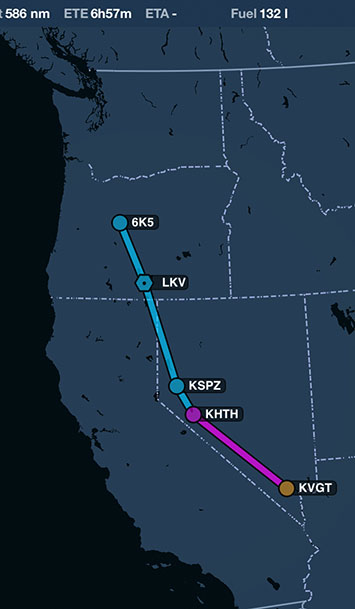
Since July 16th 2018 I had an FAA PPL, but I still wasn't allow to fly my 140. I needed a tailwheel training. I heard that Brian Lansburgh is one of the best instructors for this. Furthermore, I liked his website tailwheelersjournal.com , so I booked his course. He operates out of Sisters, Oregon and I wanted to become trained on my own aircraft. Therefore, N5581M needed to be flown from North Las Vegas (KVGT) to Sisters (6K5). Jon, the previous owner, did the job in a single day. He took off July 27th, prior to 5 AM. The map above shows his fuel stops in Hawthorne (KHTH), Silver Springs (KSPZ) and Lake View County (LKV). According to the map it is 586 nautical miles, but you cannot fly the straight lines shown in the picture, there are mountains and restricted areas in-between. It is more than 8 hours pure flight time. Even with good weather and 14-hours between sunrise and sunset hard to do in a single day. Jon even managed to fly home commercial on the same day.

It was a clear and sunny day, when I left Frankfurt 5 weeks later on August 22nd. When it is sunny in Frankfurt, runway 07 is in use. Airliners departing on 07 and heading towards the north circumnavigate the city of Frankfurt in the east. I had a window seat, picture shows Frankfurt as seen from the east, looking west. Taunus mountain in the background, right side. I was traveling alone. Could spare 5 days max to get the endorsement.

After changing planes in Seattle, I continued with a regional to Redmond. When he left cruise, the turboprop passed a few volcanoes. I think this one is one of the Sister mountains, giving Sisters its name.

Was too tired to drive and stayed the first night in a motel in Redmond. August 23rd at 3 AM, I drove the 20 miles to Sisters. Sisters is a lovely little town and the airport wasn't hard to find. I was to meet Brian at his house, where N5581M was parked. Brian lived in "Pilot drive", a street shared between cars and aircraft. Aircraft usually have the right of way. All houses at Pilot Drive have hangars for their owner's planes.
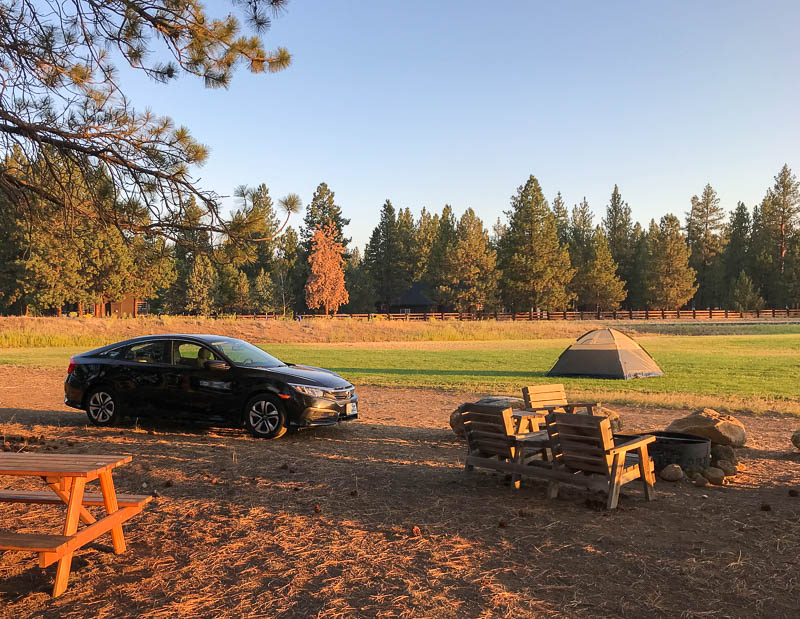
It was summer and the weather lovely. Decided to camp next to Sisters runway. Pilot Drive is on the other side of the runway, in the trees.
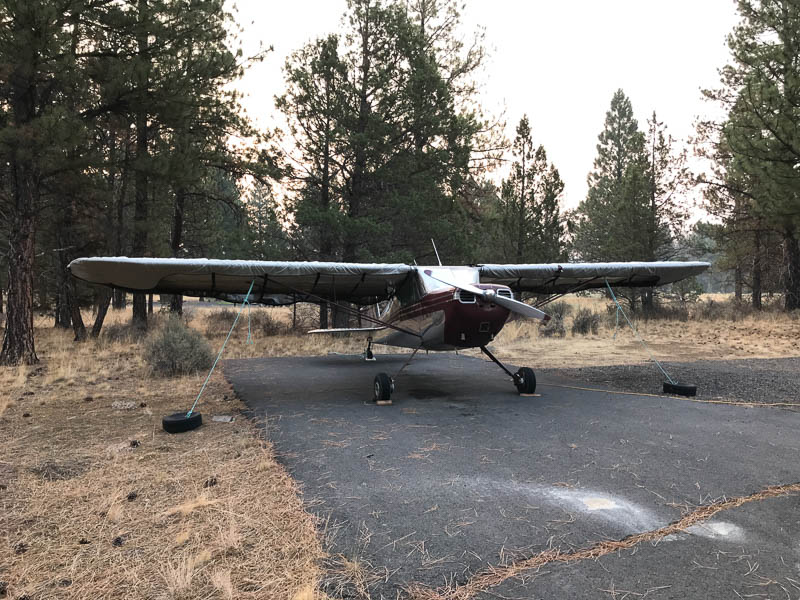
Brian has everything, even a wing cover for a 140. Important for a fabric wing aircraft parked outside for a prolonged time.
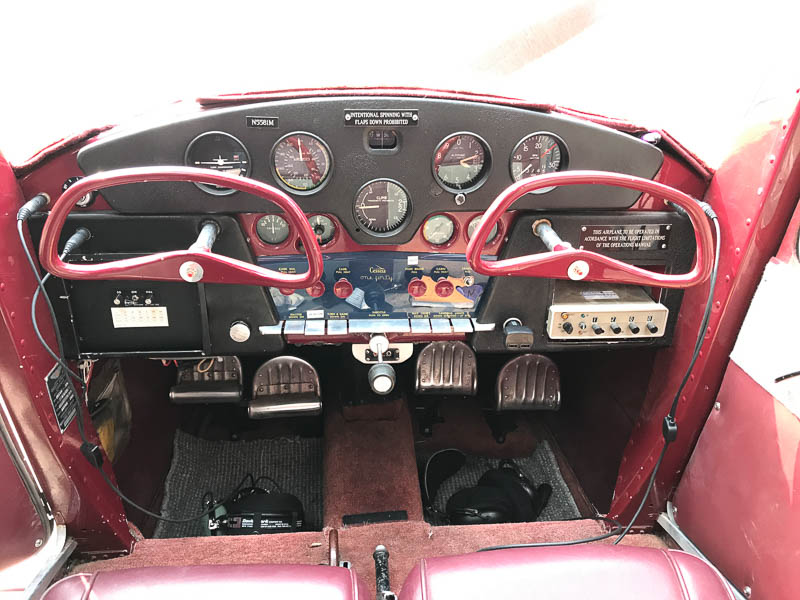
Found her the way I left her in North Las Vegas. Still with the old (non ADS-B compliant) transponder. (The grey box on the right side) The old VHF can not be seen on this picture, it is covered by the left control wheel.

The ceiling is covered by a thin material, which was already torn, when I purchased the plane. Around the left wing's fuel gauge, the fabrics was missing completely. Ace Air LLC replaced it a few weeks later with a new headliner. They did a nice job, can recommend them.

During the training course, I was busy. No time to take pictures. Brian was fantastic, showing me lots of things I hadn't done in 29 years of flying before. He took the picture above, showing me flying low circles in the irrigation ditches. We trained at several local airports, e.g. Sunriver, Madras and Prineville. On the longer runways, we trained "multiples", that is landing several times. Our patterns were always low and tight, so we did lots of touch and goes per hour. He showed me how to spin her, how to avoid spins and - most important - how to get out of a spin. (The 140 has no stall warning and a powerful rudder, inadvertent spins do happen and have killed hundreds of pilots). Last time I spinned an aircraft was 28 years ago on a Beech Mentor. Always good to refresh these skills.

Over 3 days I received about 5 hours of tailwheel training. Every evening, I was returning to my tent and watched the deer feeding next to the runway. On the fourth and planned last day of the training, my VHF failed. Surprisingly, Brian had no fitting spare in his hangar. For touch and go training on uncontrolled fields it is not mandatory, but you better use a radio. So, we couldn't fly N5581M anymore.

We switched to N2128V, a Cessna 120 from 1948, owned by Outlaw Aviation and available for tailwheel training.

Compared to my 140, this 120 had a lot of instruments. But it felt just the same and finishing training with it, was no problem. After Brian believed that I was proficient to land a taildragger, he showed me a few things from his "Stick and Rudder Master Class", but I didn't get deeply into it, time was already over. I didn't feel really proficient, when Brian endorsed my logbook. Proficiency comes with practice and I guess it usually takes at least 100 tailwheel landings, until someone is comfortable with it. Did only 40 landings with Brian. As we pilots all know, feeling proficient and comfortable creates a new risk: Complacency. Flying is dangerous. Never forget this. While doing touch and goes in Prineville, I witnessed an accident. Someone ground-looped his 170. Nobody got hurt, but the left wheel broke off, leading to a damaged left wing and a prop strike. Stopping a running prop by a strike always leads to an engine overhaul, so the damage was likely beyond 50 grands. "I endorsed him", Brian commented drily.
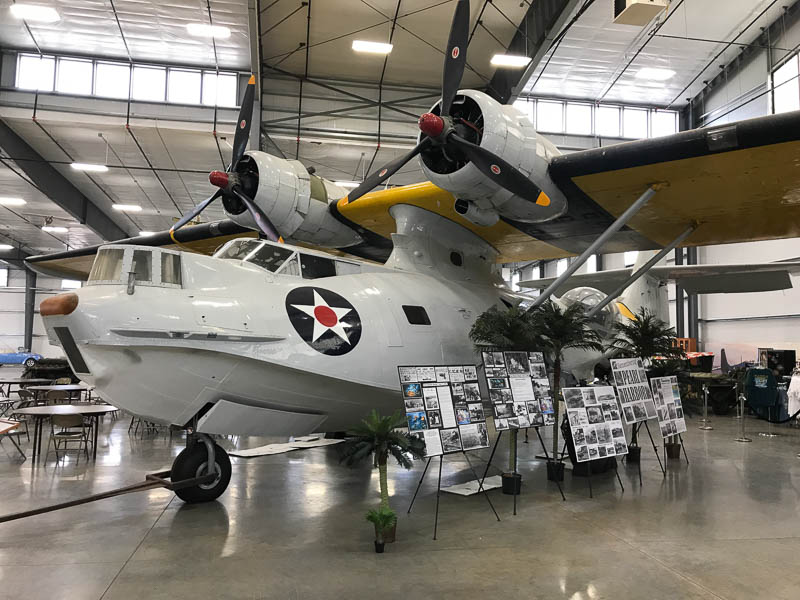
Beside flying, Brian showed me a few other things. Hand-propping the engine or good tie-down knots, for example. And he showed me "Erickson's hangar" in Madras. (ericksoncollection.com) Must have known, I love aircraft museums.

August 26th, after 4 days of flying taildraggers, I took the regional back to Seattle. Much higher than during the last days, I had a last view on Sisters. See the runway in the center of the picture? The far end leads towards the village, with lots of houses. The near end points to a hill, impossible to climb over it in a heavy 120 or 140. When departing Sisters runway 20, you better start a prominent left turn at the end of the runway, before the hill, and use the valley to increase speed, before starting to climb. All this by using ground effect, if necessary. It is a really different way of flying, from what I did all my live (including my initial training in the Lufthansa flight school). My flight training back than was done to create airline pilots and most flight training nowadays is done this way. Student pilots learn to fly their small aircraft like they are later supposed to fly the big ones. This is the way to do it, if you want airline pilots. But this is not ideal for flying small planes, as skills essential for them, are not being teached. This can lead to unsafe situations, as Brian points out in many good articles readable on his tailwheelersjournal.com or in his excellent "Brian's Flying Book".
I was heading home now. Back to my team in the office and to the Airbus I usually fly. But I already longed to return to Sisters and start flying my plane finally by myself.